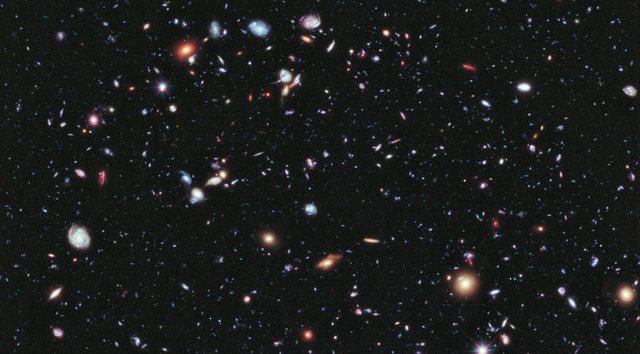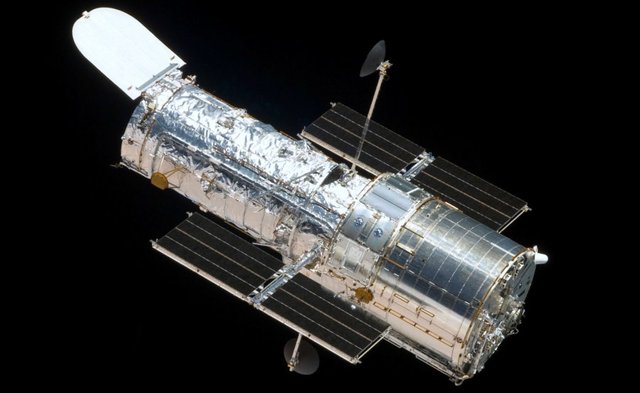A Picture Of 13 Billion Years
There's an English adage about the notion that a complex idea can be conveyed with just a single image; "A picture is worth a thousand words." This is true. Especially when living in a universe in which the speed of light is constant, and the Hubble Space Telescope exists...

Hubble eXtreme Deep Field (HXDF) taken in 2012 - source: Wikipedia
The only constant in Einstein's famous equation, E=MC2, is the speed of light. And because in physics "speed" is defined as "the distance traveled per unit of time," we are actually looking back in history when we look up at the stars; the light we observe, left a particular star many years ago. Even when looking at our own local star, the Sun, we are looking approximately 8 minutes back into the past as the light takes 8 minutes to traverse the distance between it and our planet. That is, if we measure the photon's path from the surface of the Sun;
"A photon of light takes only eight minutes to get to the Earth from the surface of the Sun. But it can take 100,000 years from the core of the Sun to get to the surface - where it bursts out and flies at the speed of light."
source: ABC Science
Follow the link to read more about the "slow light" inside stars, for this article only the speed of light as we know it is relevant: 299,792,458 meters per second (approximately 300,000 km/s (186,000 mi/s)). Three-hundred-thousand kilometers per SECOND; no matter how often I see this number, I'm in awe every time. To share some of that feeling with you today, dear reader, I want to introduce you to the most amazing picture ever made, and it's not the world famous Hubble Deep Field which has been with us since 1995 already:
"The Hubble Deep Field (HDF) is an image of a small region in the constellation Ursa Major, constructed from a series of observations by the Hubble Space Telescope. It covers an area about 2.6 arcminutes on a side, about one 24-millionth of the whole sky, which is equivalent in angular size to a tennis ball at a distance of 100 metres. The image was assembled from 342 separate exposures taken with the Space Telescope's Wide Field and Planetary Camera 2 over ten consecutive days between December 18 and 28, 1995."
source: Wikipedia

The Hubble Space Telescope in orbit. - source: Wikipedia
Since then, several more of these kinds of pictures have been made, gradually pushing the Hubble telescope to it's limits, producing ever deeper and more detailed pictures of tiny pieces of the night's sky; in 2004 we got the Hubble Ultra-Deep Field (HUDF), followed by the eXtreme Deep Field (XDF) in 2012. But all these were just the precursors of the picture they released a couple of weeks ago, the Hubble Legacy Field:
"The ambitious endeavor, called the Hubble Legacy Field, includes several Hubble deep-field surveys, including the eXtreme Deep Field (XDF), the deepest view of the universe. The wavelength range stretches from ultraviolet to near-infrared light, capturing all the features of galaxy assembly over time.
The image mosaic presents a wide portrait of the distant universe and contains roughly 265,000 galaxies. They stretch back through 13.3 billion years of time to just 500 million years after the universe's birth in the big bang. The tiny, faint, most distant galaxies in the image are similar to the seedling villages from which today's great galaxy star-cities grew. The faintest and farthest galaxies are just one ten-billionth the brightness of what the human eye can see."
source: HUBBLESITE
On the website linked above you can download the full resolution, uncompressed picture, but be warned: it's more than a gigabyte and can crash your computer if you don't have enough RAM and / or disk-space! Like the narrator of the below linked video, I managed to open the image in GIMP, the free open source Photoshop-like image editing program. And by all means, please watch the video if you don't want to go through the trouble of downloading the actual image. Oh, and he has a Lego set of the telescope too:
This Image from Hubble Telescope Is Absolutely Mind Blowing
Thanks so much for visiting my blog and reading my posts dear reader, I appreciate that a lot :-) If you like my content, please consider leaving a comment, upvote or resteem. I'll be back here tomorrow and sincerely hope you'll join me. Until then, keep steeming!

Recent articles you might be interested in:
| Latest article >>>>>>>>>>> | A Piece Of The Pie |
|---|---|
| Boredom's Surprising Blessings | A Fantastic Rule |
| Law Of Malfunctioning | The Price Of Reality |
| Hannibal Lecter Rules | The Harder They Come... |

Thanks for stopping by and reading. If you really liked this content, if you disagree (or if you do agree), please leave a comment. Of course, upvotes, follows, resteems are all greatly appreciated, but nothing brings me and you more growth than sharing our ideas. It's what Steemit is made for!


Just for Full Disclosure, I'm invested in these crypto-currencies:
Bitcoin | Litecoin | EOS | OmiseGo | FunFair | KIN | Pillar | DENT | Polymath | XDCE | 0x | Decred | Ethereum | Carmel | XYO

@helpie is a WITNESS now! So please help @helpie help you by voting for us here!
